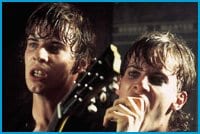Constantly surprising and innovative, Brothers Of The Head is a fictional documentary about conjoined twins Tom and Barry Howe. Born and raised in isolated rural England, the teenage boys are sold by their father to a novelty-act impresario and brought to a mansion to be moulded into proto-punk stars in the mid-1970s. The name of their act, The Bang-Bang, perfectly captures their double-barrelled, loose-cannon adolescent sexuality.
Make-believe and real, tragic and absurd, rock concert and freak show, Brothers Of The Head is nothing short of the queerest film of the year — and unquestionably one of the best — a heartbreaking must-see masterpiece for all unabashed punks, freaks, art fags and film geeks. Directed by gay couple Louis Pepe and Keith Fulton, it is also a madly eye-popping and ear-splitting experience.
The brothers’ wild and woolly story is recounted by everyone, save the boys themselves: the musician, the manager, the sister, the lawyer, the journalist and so on. We also see meticulously staged vérité-style footage of the brothers’ antics as well as experimental Super-8 movies they made themselves. Then there are the clips of real director Ken Russell’s imaginary Two-Way Romeo (also the name of The Bang-Bang’s signature hit), a typically lurid and Vaseline-lensed creative interpretation, which will leave fans of the decadent British pervert-director squealing with glee.
Writing raucous autobiographical lyrics — Barry’s a ball of rage but Tom’s a balladeer at heart — the twins take the pre-punk music scene by storm. Thrust into a rowdy pub for their first show, they are assailed by homophobic catcalls: “Who’s this, two puffs coming on cuddling each other?” The boys respond with a fuming, visceral performance that climaxes when Barry rips open his shirt to expose the fleshy join that connects their torsos. Everyone goes crazy. Fans reach out and try to touch the band of skin that attaches boy to boy: “Are you you or are you me?” the twins scream, with Barry going so far as to suck fraternal face to get a rise out of people.
In the midst of this fantastic spectacle, Brothers Of The Head does actually work as a documentary about the subversive power of performing deviance. (Keep in mind that people whom we would now call trans, intersex or disabled were historically displayed in freak shows.) The boys take their aberrant body (bodies?) that will never be normal, and shove it in people’s faces with a raw snarl.
Barry and Tom, played by real-life identical twins Luke and Harry Treadaway, are stunning. Drop-dead gorgeous, they seem to perfectly understand being not really two and not really one. Sometimes functioning in perfect harmony but often at each other’s throats, they are stuck in a state of constant physical embrace — literally inseparable — and the queerness of their doubled body is incredibly suggestive. Barry and Tom gaze accusingly at the documentarian’s lens, reminding us that their privacy is being constantly invaded; painfully (and pleasurably) aware that they are perpetually on display.
The film feels refreshingly loose and freewheeling thanks to the actors’ improvisation: A scene where the twins casually poise a bread-knife at the join and joke about being surgically separated starts off wrenchingly sad but descends into juvenile clowning. These are your average hormone-charged, loutish British lads at heart, and their testosterone spiked with drugs, booze, lust and angst soon blows the whole Bang-Bang sky high.

 Why you can trust Xtra
Why you can trust Xtra


